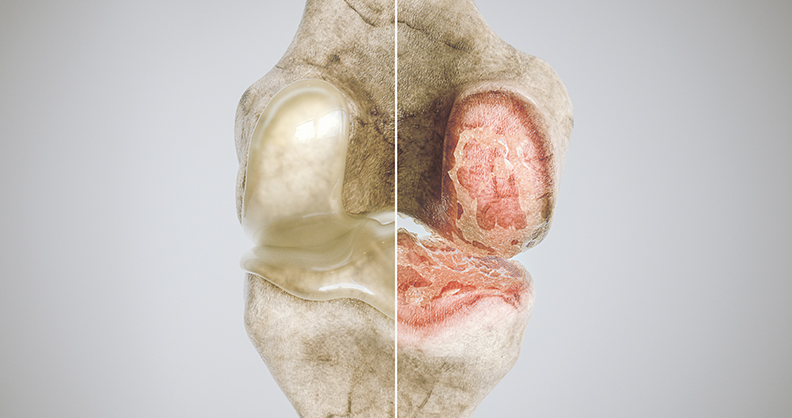
UF Scripps Biomedical Research scientists recently discovered a way to prevent osteoarthritis, also known as degenerative joint disease. This form of arthritis occurs when flexible tissue at the ends of bones wears down. Osteoarthritis is said to plague more than three million adults in the U.S. alone.
The UF Scripps researchers discovered that activating the RORβ protein has the potential to restore joints to healthier levels and reduce inflammation. Activating RORβ could serve as a useful new strategy to prevent or delay the development of degenerative joint disease, said Patrick Griffin, Ph.D., Professor and Scientific Director at UF Scripps Biomedical Research.
The important discovery was inspired by the desire to study a specific protein overlooked by orthopedic researchers. The lab’s study focused on a family of proteins called nuclear receptors.
“One subfamily, the RORs, is of particular interest to us, and we have published several major papers on these proteins,” Dr. Griffin said. “For our recent publication, we set out to determine what genes were controlled by the beta isoform of the RORs, a receptor that has received little attention because of its limited expression throughout the body. RORβ has been suggested to play a role in bone homeostasis. We engineered a cell line that is osteoblast-like, with RORβ being overexpressed.”
Dr. Griffin highlighted the importance of the discovery and its vast potential to improve patient care by pointing out that osteoarthritis is the top cause of disability in the U.S. He stressed the need for a medication that addresses the root cause of cartilage damage and depletion. Despite studying causes of bone diseases for many years, Dr. Griffin said that he and his colleague Mi Ra Chang, Ph.D., were surprised by the study’s findings.
“Previously published work by other scientists had suggested a role for RORβ in bone, and a relationship with osteoporosis,” he said. “We found that the majority of genes altered by overexpression of RORβ were supportive of chondrogenesis, which is protective to cartilage degradation and also anti-inflammatory. This suggests a protective role for RORβ in the context of osteoarthritis.”
RORβ, which stands for retinoic acid receptor-related orphan receptor beta, is a type of nuclear receptor protein. Genes in human cells switch back and forth between periods of activity and inactivity. When nuclear receptors bind to DNA, they activate a cell into the process of transcribing genes into proteins. RORβ’s role in maintaining cartilage health has been unclear until now, though it’s previously been linked to the development of the retina during fetal growth in the eye.
Dr. Griffin expressed optimism and excitement when asked what was next for their findings and what potential applications exist for the orthopedic and joint replacement markets. He said financial support would help fund more research into inducible stem cells to validate the published findings in different cell models.
“We would also test gene delivery and other mechanisms for increasing RORβ expression in rodent models of osteoarthritis,” Dr. Griffin said. “This study suggests RORβ could be an attractive therapeutic target. However, there’s much more we need to unravel. Specifically, we want to understand more about the mechanism by which RORβ impacts chondrocytes and blunts the inflammatory signals that lead to cartilage destruction.”
PM
Patrick McGuire is a BONEZONE Contributor.




